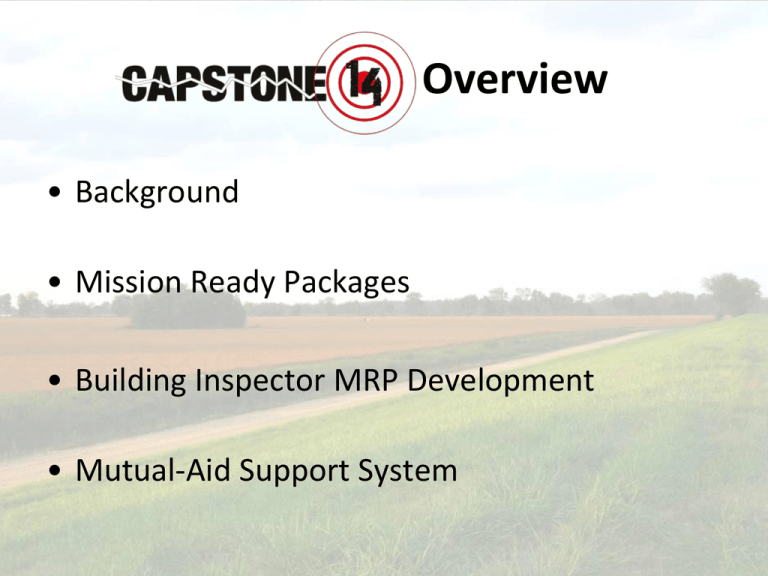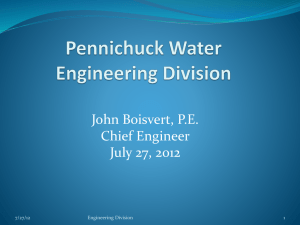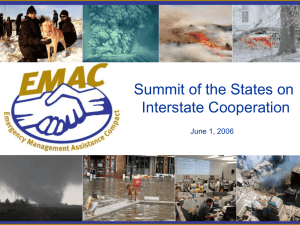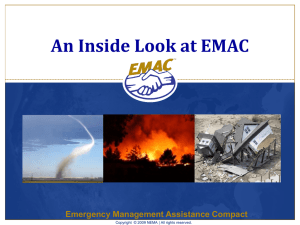MEMA SAR Planning Meeting Part 3
advertisement

Overview • Background • Mission Ready Packages • Building Inspector MRP Development • Mutual-Aid Support System CAPSTONE-14 Background • June 16-20, 2014 • Regional Focus – – – – – – Communications Situational Awareness Private Sector Transportation Resource Allocation Civilian Authority Support What is EMAC System that allows States to help each other during a disaster… “EMAC offers assistance during governor-declared states of emergency through a responsive, straightforward system that allows states to send personnel, equipment, and commodities to help disaster relief efforts in other states. “ www.emacweb.org The EMAC Process PRE-EVENT PREPARATION The EMAC Process: ACTIVATION REQUEST & OFFER begins before emergency occurs comprises five distinctive phases involves states affected by an emergency as well as states assisting them ends when Requesting State reimburses Assisting State RESPONSE REIMBURSEMENT Courtesy National Emergency Management Agency Mission Ready Packages (MRP) • Specific response and recovery capabilities • Organized, developed, trained & exercised prior to an emergency • Based on NIMS Resource Typing • Developed in cooperation with Resource Providers 1. Speed – Faster Response 2. Reimbursement - Reduce Issues Image: National Emergency Management Association Equipment • Dump truck • Articulating rubber-tired loader • GPA Units • Chain saws • Cameras • Costs Personnel Commodities • Fuel • Spare chains, bars, oils, files • Costs • Personal protective gear • Positions or names with contact information • Salaries/fringe benefits Example: Debris Removal Support Package Food • Per diem rates • Receipt estimates Travel/Lodging • Per diem rates • Receipt estimates • Airfare • Mileage • Costs • • • • Other Costs Decontaminatio n Maps of disaster area Equipment rehabilitation Costs Courtesy: Kentucky Emergency Management MRP Templates Building Safety Evaluations M5.8 Mineral, VA Earthquake • 8/23/2011 • $150M in Damages • 150,000 felt reports Maximum Intensity VII • Building Inspectors “imported” from CA • CUSEC States had/have trained inspectors Map Source: US Geological Survey CUSEC Post-Disaster Building Safety Evaluation Strike Teams Mission TYPE I TYPE II TYPE III Conduct RAPID AND DETAILED SAFETY EVALUATIONS OF COMPLEX BUILDING STRUCTURES Conduct RAPID AND DETAILED SAFETY EVALUATIONS and assist Type I teams Conduct RAPID SAFETY EVALUATIONS and assist Type I and II teams (> Three stories, irregular building design, soft story construction, critical facilities, etc.) (Non-critical low rise structures up to three stories) May also conduct Safety Evaluations normally done by Type II and III Teams (Residential single-family wood framed structures; single story buildings of less than 10,000 square feet) May also conduct Safety Evaluations normally done by Type III Teams CUSEC Post-Disaster Building Safety Evaluation Strike Teams Personnel TYPE I TYPE II TYPE III 2 PERSONS 2 PERSONS 2 PERSONS 1 LICENSED STRUCTURAL ENGINEER or ARCHITECT with 5 yr. experience in design and/or construction and 1 LICENSED ENGINEER or ARCHITECT 1 LICENSED ENGINEER or ARCHITECT and 1 NON-LICENSED ENGINEER or ARCHITECT or 1 CERTIFIED BUILDING INSPECTOR or CODE OFFICIAL NOTE: AT LEAST ONE LICENSED ENGINEER or ARCHITECT, INTERNATIONAL CODE COUNCIL (ICC) CERTIFIED BUILDING OFFICIAL/INSPECTOR, or NON-LICENSED ENGINEER or ARCHITECT is preferred for this team CUSEC Post-Disaster Building Safety Evaluation Strike Teams Training TYPE I TYPE II TYPE III Recommended FEMA Emergency Management Institute (EMI) Courses: •IS-100 Incident Command System (ICS) •IS-700 National Incident Management System (NIMS) •IS-800 National Response Framework (NRF) and Choice of building inspector training: ATC-20 Post Earthquake Safety Evaluation of Buildings and ATC-45 Safety Evaluation of Buildings After Wind Storms and Floods or one of the following: •Missouri SAVE Coalition training •California EMA Safety Assessment Program (CalSAP) •International Code Council (ICC) disaster response training for code enforcement officials Common Building Inspector EMAC Considerations • Liability / Workers Compensation • Deployment Limitations – Scope of deployment – Level of training – Functions described by mission order • Home State rule for licensure Why are we working on Deployable Building Inspector Resources? • To develop EMAC based/resource-typed building inspection teams • To provide an “all-hazards”, national resource • To identify earthquake mitigation priorities through building inventory and evaluation • To provide potential building inspectors training and practical experience All will be tested and validated in Mutual Aid Support System (MASS) • GIS software that focuses on Mission Ready Packaging for mutual aid (Intrastate & EMAC) • MASS integrates with current EM resource management software (flexible) • Resource providers control who can see resource inventory Finding deployable resources on a map… Easily See MRP Status Courtesy: Kentucky Emergency Management Sample Incident: Intrastate HazMat in N. Kentucky Sample Incident: EMAC HazMat in Southern, OH Next Steps • Finishing touches on Building Inspector MRPs • MRP Templates --> States --> EMAC/MASS • Work to train, recruit volunteer inspectors • Exercise, Validate, and Update MRPs in CAPSTONE-14 cusec.org/capstone Brian Blake Central U.S. Earthquake Consortium bblake@cusec.org











